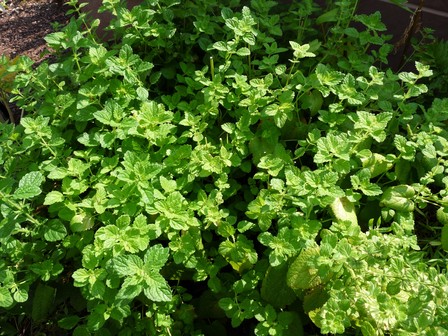Back to Tour: Medicinal Plants Tour
|
Melissa officinalis Lemon Balm |
Denver Botanic Gardens
Gardens Navigator 
|
|
Accession Number: 032894*10 Map | |
| More about Melissa officinalis | |
| TOUR DETAILS |
Medicinal uses: Among other properties, lemon balm has antidepressant, antispasmodic, antiviral, diaphoretic (increases sweating), febrifuge (reducing fever) and sedative properties. Lemon balm has been known to help soothe digestion problems, such as bloating or indigestion and IBS. It also has chemicals which help lower the activity of the thyroid, which makes it a useful treatment for hyperthyroidism. Lemon balm can ease anxiety or stress and combined with valerian has been found to be a good sleep promoter. Applied topically, lemon balm is also known to help remove cold sores and fever blisters. Mythology/Folklore: Lemon balm is an herb that does not get the attention it deserves. It is part of the mint family, but instead of having a strong mint smell, has a strong lemon scent. The name “Melissa” comes from the Greek word for “honeybee,” as the bees pollinated these plants. In fact, the Greek beekeepers planted lemon balm near their temple of Artemis to keep the sacred honeybees content. Ancient Arab physician used the leaves from lemon balm as prescriptions for those suffering from melancholy. Emperor Charlemagne, back in the ninth century, was so impressed by the properties of lemon balm that he ordered it to be planted in all monastery gardens. More recently, scientists have found that lemon balm helps to improve memory, the ability to learn, store, and retrieve information. For these reasons, lemon balm is often recommended to those with Alzheimer’s, dementia, and ADHD. Medicinal recipe: Iced Lemon balm Tea: Pour 4 cups of boiling water over an herb combination of 1 teaspoon of dried lemon balm leaves, 1 teaspoon of dried peppermint, and 1 teaspoon of chamomile flowers. Mix the herbs together in a large bowl. Let this mixture steep for 10-15 minutes. Strain out the herbs and pour the liquid into a clean pitcher. Add 1 tablespoon of honey and 1 to 2 cups of ice cubes. Culture: (from staff horticulturalist Blake Burger) “Lemon balm prefers rich soil a sunny or mostly sunny location. Lemon balm can thrive in a location that only receives a half day of sun as well. Lemon balm responds well to cutting so don’t be afraid to harvest the lemon scented leaves as needed. To prevent lemon balm from seeding around your garden, be sure to cut back the plant about 1/3 just after flowering.” |
| LOCATION GROUP | Scripture Garden |
| FAMILY NAME | Mint Family |
| FAMILY | Lamiaceae |
| ACCESSION DATE |
September 11, 2003 (When this plant was acquired and registered in the database) |
| FLOWER COLOR | yellow;purple;white |
| FLOWER COLOR NOTE | immature flowers ;light purple when mature ;when over mature |
| USDA HZ | 3 (Coldest Zone Where Hardy) |
| HABIT | Herbaceous (Non-woody); Rhizome |
Location Map for 032894*10 Melissa officinalis
Map Help
Flowering
When Melissa officinalis has been observed flowering at Denver Botanic Gardens
 | ||||||||||||||||||||||||||||||||||||||||||||||||||||
| 2012 |  |
 |
 |
 |
 |
 |
 |
 |
 |
 |
 |
 |
 |
 |
 |
 |
 |
 |
 |
 |
 |
 |
 |
 |
 |
 |
 |
 |
 |
 |
 |
 |
 |
 |
 |
 |
 |
 |
 |
 |
 |
 |
 |
 |
 |
 |
 |
 |
 |
 |
 |
 |
| 2005 |  |
 |
 |
 |
 |
 |
 |
 |
 |
 |
 |
 |
 |
 |
 |
 |
 |
 |
 |
 |
 |
 |
 |
 |
 |
 |
 |
 |
 |
 |
 |
 |
 |
 |
 |
 |
 |
 |
 |
 |
 |
 |
 |
 |
 |
 |
 |
 |
 |
 |
 |
 |

© Denver Botanic Gardens, 1007 York Street, Denver, CO 80206
Photography © Denver Botanic Gardens

Powered by







 E-mail
E-mail